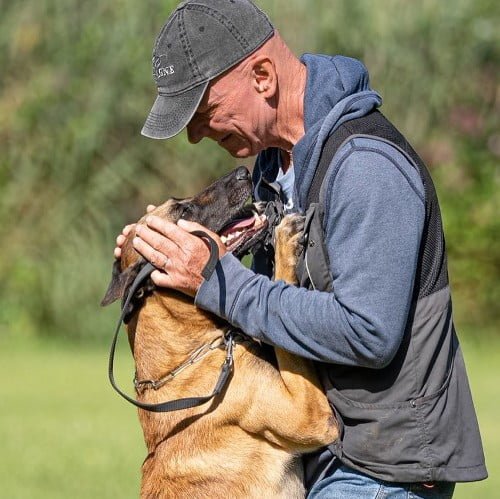You may have to work hard to train your dog not to pull on a leash, but it’s definitely worth the effort. Most dog owners struggle with getting their pup to walk nicely on a leash and end up resorting to using a choke chain or prong collar which can be harmful and cruel.
It’s no secret that teaching your dog leash walking is one of the most important things you can do as a pet owner, but it’s also one of the most difficult. This can be a frustrating experience for both the dog and the owner. Not only is it difficult to control the dog, but it’s also very uncomfortable for the person walking him or her.
In this blog post, you can learn about leash training and will also outline some tips for training your dog to walk without a pull on a leash. Let’s get started!
Why is it important to train your dog to walk without pulling?
A leash-trained dog will be able to walk without pulling on a leash for a number of reasons.
1. Safety of Dog and Owner:
First and foremost, it’s important for the safety of both the dog and the owner. If the dog is constantly pulling on the leash, he or she could easily get hurt or even break free from the leash and run into traffic. Dogs that pull on their leash are often more likely to get themselves into dangerous situations, such as getting tangled in the leash or running into traffic. If you teach your dog to behave properly on a leash, you can help keep both of you safe.
2. Comfortable:
For one, it’s much more comfortable for you and your dog if he or she isn’t pulling on the leash. The person walking the dog feels very uncomfortable when the dog pulls on the leash. If you’ve ever been pulled down the street by a dog that’s not walking nicely, you know how frustrating and painful it can be. Not only does it hurt your arm or shoulder, but it can also cause you to trip and fall.
3. Good manners:
Leash-pulling dogs are often viewed as rude or unruly, and it can be frustrating for both you and the people around you. Leash-pulling dogs are often seen as “bad” or “untrained.” If you’re taking your dog out in public, it’s important that he or she knows how to behave and walk politely on a leash.
How to train your dog to walk on a leash without pulling?
One of the most common problems that dog owners face is their dog pulling on the leash while out on walks. This can not only be frustrating for you, but it can also be dangerous for your dog if they are constantly yanking on the leash and trying to run ahead. Luckily, there are a few things that you can do in order to train your dog to walk calmly on a leash without pulling.
1. Using the correct type of Leash:

The first thing that you need to do is make sure that the leash you are using is appropriate for your dog. If you are using a collar and leash combo, then you will want to make sure that the leash is attached to the front of the collar instead of the back. This will help to prevent your dog from being able to pull on the leash while still allowing them some freedom of movement. You may also want to consider using a harness instead of a collar, as this can give you more control over your dog and help to prevent them from pulling.
2. Heel Positioning:

Next, you will want to start out by teaching your dog to heel. This means that they should walk by your side instead of in front of or behind you. You can do this by using treats or a toy as a lure to get them to move next to you. Once they are walking calmly by your side, you can start to add in some distance and have them walk ahead of you for a short distance before calling them back to your side.
3. Positive reinforcement:
It is also important to keep in mind that you should never punish your dog for walking calmly on a leash. This will only make them more likely to pull in the future. Instead, focus on rewarding them when they do walk politely by your side. This can be done with treats, petting, or even just verbal praise.
4. Consistency:

It’s important to remember that one of the keys to teaching your dog to walk on a leash is to be consistent. If you allow your dog to pull on the leash sometimes, he will think it’s okay to do it all the time. Be sure to always correct him whenever he pulls, and eventually he will learn that it’s not acceptable behavior.
5. Patience:
In addition to being consistent, it’s also important to be patient when training your dog to walk on a leash. This is a process that takes time and patience, but eventually, your dog will get the hang of it. Do not get frustrated or give up if it seems like your dog is not progressing. With time and patience, he’ll learn how to walk without pulling.
Tips on how to make leash training more effective
Below are a few tips to make leash training much more effective:
1. Start by attaching the leash to your dog’s collar and having them wear it around the house for short periods of time. This will help them get used to the feel of the leash and will make the training process go more smoothly.
2. Start with a short leash and gradually lengthen it as your dog becomes more comfortable with walking on a leash.
3. If your dog seems resistant to leash training, try using a different type of collar or leash, or consult a professional trainer for assistance.
4. Teach your dog the basic commands of sit, stay, come, and down. These will be the foundation for all other training.
5. As you’re walking, give your dog frequent praise and rewards for walking calmly at your side.
6. If your dog does start to pull, don’t jerk on the leash or yell at him. This will only make the problem worse. Instead, stop walking and stand still until he calms down. Then start walking again.
7. Keep sessions short and fun, and eventually, your dog will be able to walk politely by your side!
8. Be consistent with your commands and rewards, and remain patient while your dog learns the correct behavior. With time and patience, you’ll be able to enjoy walks with your dog instead of feeling like you’re being dragged along.
Remember that leash training is a lifelong process, so be prepared to put in the time and effort required to make it successful.
Conclusion
Walking your dog on a leash can be an enjoyable experience for both of you when done correctly. Walking a dog on a leash calmly is possible if you train it properly, but it takes time and patience. With a little bit of effort, you should see positive results and have a well-behaved dog that walks nicely by your side on its leash.
Hopefully, the leash training you have done for your dog should have helped you discourage his pulling behavior. Stay consistent with your training and be calm, and soon you and your furry friend will be able to enjoy leisurely walks together. Have you tried any of these methods to train your dog? Let us know in the comments below. Thanks for reading!
FAQs
Does it take long to train a dog not to pull when walking on a leash?
Each dog responds differently to training when it comes to not pulling on a leash. Some dogs catch on quickly and others may need more time and patience. However, with consistency and positive reinforcement, most dogs can be trained not to pull on the leash.
Why does my dog pull so hard on the leash?
There are a number of reasons why your dog may pull on the leash. It could be that they are excited or anxious, they want to get to something or someone ahead of them, or they may simply not be used to walking on a leash.
What kind of leash is best for a dog that pulls?
A leash that is comfortable for both you and your dog is important, as is one that will allow you some control over your dog’s movements. A harness with a front clip may be a good option for dogs that pull, as it gives you more control over which direction they go in. You may also want to try a head collar, which attaches around your dog’s muzzle and gives you more control over their head and neck movements.
Do harnesses encourage pulling?
No, a harness is not likely to encourage your dog to pull more than he already does. If you have a dog that loves to pull on the leash, a front-attaching harness can give you more control and may even help to teach your dog not to pull.





